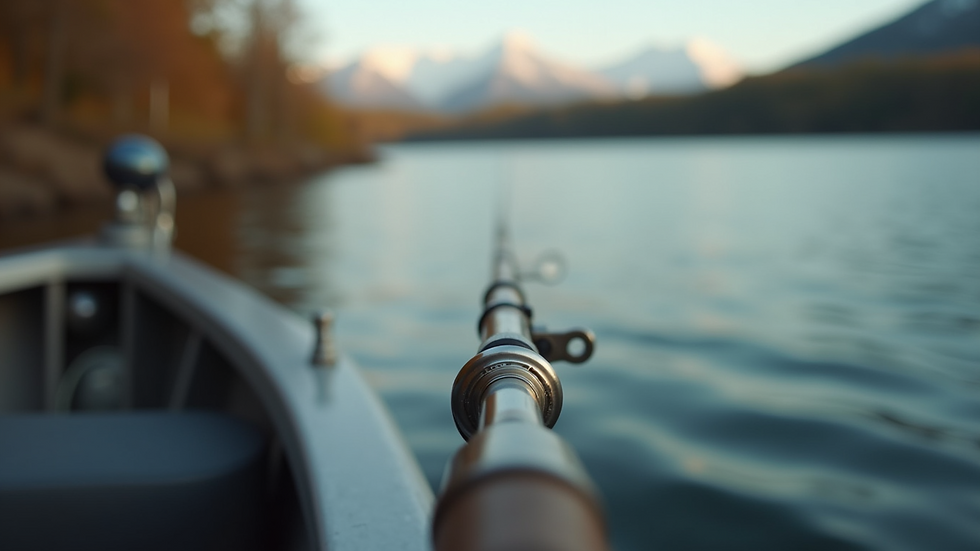Reel It Back Together How to Fix Your Broken Fishing Pole Like a Pro
- Flying Fishman

- Jun 24
- 4 min read
Fishing is one of the most enjoyable outdoor activities, combining relaxation with excitement. But nothing ruins a perfect day on the water faster than a broken fishing pole. A snapped rod, a glitchy reel, or loose guides can happen unexpectedly. Luckily, many issues can be fixed at home without needing a professional. With a bit of patience and the right tools, you can get your fishing pole back in shape quickly. This guide will show you how to restore your broken fishing pole so you can continue enjoying your favorite fishing spots.
Understanding Your Fishing Pole
To effectively repair your fishing pole, you first need to understand its parts. A fishing pole typically has:
Rod: The long, flexible stick that gives the pole its shape and strength.
Reel: The mechanism that winds and releases the fishing line.
Guides: Small rings along the rod that allow the fishing line to run smoothly.
Handle: The part you grip while reeling in your catch.
Being familiar with these components will help you diagnose and address any issues that arise more easily.
Common Fishing Pole Problems
Broken Rod
One of the most frequent problems anglers face is a broken rod. This often occurs from stepping on it or casting too hard.
Repair Options:
Rod Repair Kit: You can find these kits in local fishing stores or online. They include epoxy and fiberglass cloth specifically designed to restore rods.
Example: Many anglers have successfully repaired their rods after breakage using these kits, allowing for casts that can reach up to 100 feet.
Wrap and Epoxy Method: For a quick fix, you can use electrical or duct tape to hold the broken pieces together.
Malfunctioning Reel
Reel malfunctions can lead to frustrating experiences. Common issues include line tangles and worn gears.
Solutions:
Clean the Reel: Cleaning can significantly enhance performance. Use a soft brush to remove dirt and debris and add a few drops of machine oil to moving parts.
Statistic: Regular cleaning can improve reel lifespan by up to 50%.
Replace Worn Parts: If parts like the bail or drag system are damaged, many reels have easily replaceable components.
Loose Guides
Loose guides can impede line movement and affect your casting accuracy.
Fixes:
Re-glue Guides: Use super glue or epoxy to secure loose guides in place.
Wrap it Up: Experienced anglers can use monofilament thread to re-wrap guides, adding durability to their setups.
Tools You’ll Need
Gathering the right tools is essential for effective repair. Here’s a list to help:
Rod Repair Kit: Available in sporting goods stores or online.
Super Glue or Epoxy: For quick fixes, especially on guides.
Electrical or Duct Tape: A temporary solution for broken rods.
Scissors: For cutting tape, thread, or any excess materials.
Soft Cloth: For cleaning the rod and reel.
Step-by-Step Guide to Repairing Your Fishing Pole
Now that you understand common problems and have your tools ready, let’s dive into the repair process.
Step 1: Assess the Damage
Start by examining the entire rod and reel closely. Identify whether you have a broken rod, a malfunctioning reel, or loose guides. Making notes of these issues helps streamline your repair process.
Step 2: Fixing a Broken Rod
For minor breaks:
Clean the ends of the break well.
Mix the epoxy according to the instructions.
Apply the mixed epoxy to both ends and rejoin them.
Wrap the joint tightly with the included material.
Let it cure as directed.
For severe breaks:
Cut a piece of fiberglass cloth long enough to cover the break and extend beyond it.
Apply epoxy to the rod and place the cloth over the break.
Smooth another layer of epoxy over the cloth and wrap with thread for added strength.
Allow it to cure for the recommended time.
Step 3: Repairing the Reel
Cleaning the Reel: Remove the reel from the rod and clean it thoroughly with a soft cloth.
Inspecting Parts: Unscrew the reel and check its internal parts for wear or damage.
Replace or Repair: Look for replacement parts if necessary, or apply machine oil to moving components for smoother function.
Step 4: Re-attaching Loose Guides
Removing the Guide: Clean off old adhesive or tape from the loose guide.
Re-gluing: Use super glue or epoxy to secure the guide back in place. Ensure it is straight and aligned.
Let it Set: Allow the glue to cure before using the rod again.
Handy Tips
Regularly inspect your fishing pole, especially before trips, to catch minor issues early.
Use rod socks or tubes during transport to protect against damage.
Keep a small toolbox in your fishing gear for emergencies, including super glue and tape.

Preventative Maintenance
It’s always easier to prevent damage than to fix it. Here are some practical tips to keep your fishing pole in top condition:
Store Correctly: After every trip, keep your pole in a cool, dry place. Avoid hot and humid spots that might weaken it.
Regular Cleaning: Clean both the rod and reel after each use to remove saltwater and dirt.
Handle with Care: Use gentle handling, especially when casting or landing fish.
Wrapping Up
By following these repair techniques and maintenance tips, you can fix many common fishing pole issues and prolong its lifespan. Remember that patience is essential. Taking the time to do repairs correctly will pay off when you're back on the water.
With the knowledge and guidance provided here, you should feel equipped to tackle fishing pole repairs like a pro. Happy fishing, and may your next catch be the biggest yet!




